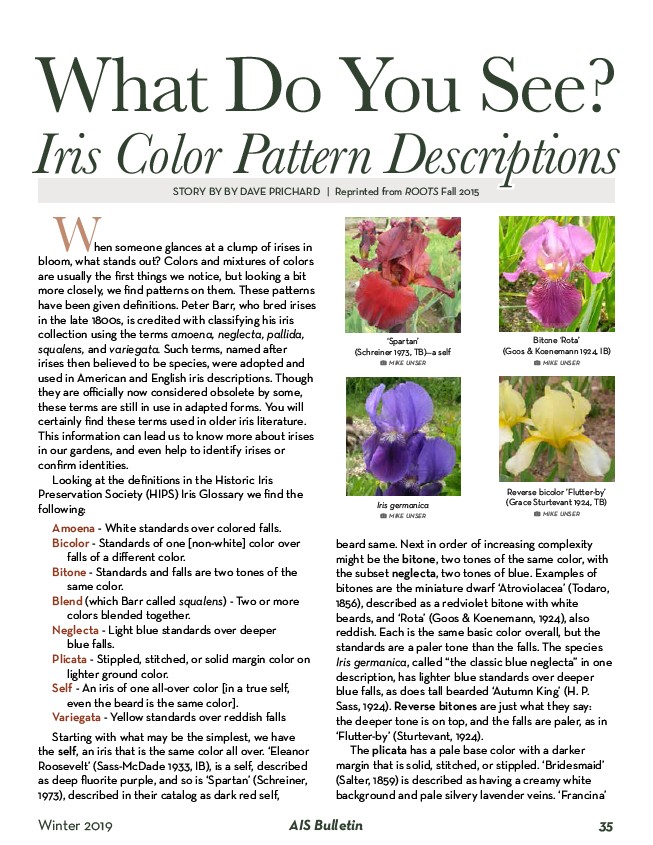
What Do You See?
Iris Color Pattern Descriptions
STORY BY BY DAVE PRICHARD | Reprinted from ROOTS Fall 2015
When someone glances at a clump of irises in
bloom, what stands out? Colors and mixtures of colors
are usually the first things we notice, but looking a bit
more closely, we find patterns on them. These patterns
have been given definitions. Peter Barr, who bred irises
in the late 1800s, is credited with classifying his iris
collection using the terms amoena, neglecta, pallida,
squalens, and variegata. Such terms, named after
irises then believed to be species, were adopted and
used in American and English iris descriptions. Though
they are officially now considered obsolete by some,
these terms are still in use in adapted forms. You will
certainly find these terms used in older iris literature.
This information can lead us to know more about irises
in our gardens, and even help to identify irises or
confirm identities.
Looking at the definitions in the Historic Iris
Preservation Society (HIPS) Iris Glossary we find the
following:
Amoena - White standards over colored falls.
Bicolor - Standards of one non-white color over
falls of a different color.
Bitone - Standards and falls are two tones of the
same color.
Blend (which Barr called squalens) - Two or more
colors blended together.
Neglecta - Light blue standards over deeper
blue falls.
Plicata - Stippled, stitched, or solid margin color on
lighter ground color.
Self - An iris of one all-over color in a true self,
even the beard is the same color.
Variegata - Yellow standards over reddish falls
Starting with what may be the simplest, we have
the self, an iris that is the same color all over. ‘Eleanor
Roosevelt’ (Sass-McDade 1933, IB), is a self, described
as deep fluorite purple, and so is ‘Spartan’ (Schreiner,
1973), described in their catalog as dark red self,
‘Spartan’
(Schreiner 1973, TB)—a self
, mike unser
Bitone ‘Rota’
(Goos & Koenemann 1924, IB)
, mike unser
Iris germanica
, mike unser
Reverse bicolor ’Flutter-by’
(Grace Sturtevant 1924, TB)
, mike unser
beard same. Next in order of increasing complexity
might be the bitone, two tones of the same color, with
the subset neglecta, two tones of blue. Examples of
bitones are the miniature dwarf ‘Atroviolacea’ (Todaro,
1856), described as a redviolet bitone with white
beards, and ‘Rota’ (Goos & Koenemann, 1924), also
reddish. Each is the same basic color overall, but the
standards are a paler tone than the falls. The species
Iris germanica, called “the classic blue neglecta” in one
description, has lighter blue standards over deeper
blue falls, as does tall bearded ‘Autumn King’ (H. P.
Sass, 1924). Reverse bitones are just what they say:
the deeper tone is on top, and the falls are paler, as in
‘Flutter-by’ (Sturtevant, 1924).
The plicata has a pale base color with a darker
margin that is solid, stitched, or stippled. ‘Bridesmaid’
(Salter, 1859) is described as having a creamy white
background and pale silvery lavender veins. ‘Francina’
Winter 2019 AIS Bulletin 35